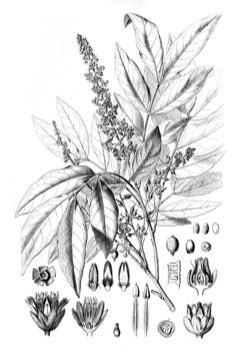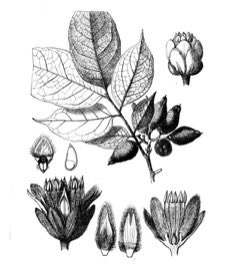 |
|
http://www.edibleplants.org |
 |
| http://www.edibleplants.org |
Translate this page:
Summary
Pitomba (Talisia esculenta), commonly found in South America particularly in Paraguay, Brazil, and Bolivia, is an evergreen or semi-deciduous tree growing up to 14 m in height and up to 40 cm in bole diameter. It is moderately fast growing. It has a dense and rounded canopy with alternate and pinnately compound leaves. The small, white flowers are produced in panicles. The brown to yellow rounded to ellipsoidal fruits, containing one or two large seeds each, are in clusters of 10 to 20. Its edible pulp can be consumed raw. The roots are antidote and can be used against jaundice when combined with annatto fruits (Bixa orellana) and fruit peel of assai (Euterpe spp.). The wood is very heavy and hard. It is used for ceilings, floor boards, door frames, boxes, carpentry, etc.
Physical Characteristics

 Talisia esculenta is a deciduous Tree growing to 10 m (32ft) by 10 m (32ft) at a fast rate.
Talisia esculenta is a deciduous Tree growing to 10 m (32ft) by 10 m (32ft) at a fast rate.
See above for USDA hardiness. It is hardy to UK zone 10.
Suitable for: light (sandy), medium (loamy) and heavy (clay) soils and prefers well-drained soil. Suitable pH: mildly acid, neutral and basic (mildly alkaline) soils. It cannot grow in the shade. It prefers moist soil.
UK Hardiness Map
US Hardiness Map
Synonyms
Sapindus esculenta A.St.-Hil.
Plant Habitats
Edible Uses
Edible Parts: Fruit
Edible Uses:
Fruit - raw[335 ]. A brown-yellow fruit with 1 or 2 large seeds covered in a thin, translucent, sweet and sour flavoured edible pulp[335 , 416 ]. Very tasty[419 ]. The fruit is about 3cm long and 2.5cm in diameter[335 ]. The fruit is borne in clusters of 10 - 20 fruits[377 ].
References More on Edible Uses
Medicinal Uses
Plants For A Future can not take any responsibility for any adverse effects from the use of plants. Always seek advice from a professional before using a plant medicinally.
Antidote
The roots are antidote. A decoction, taken internally and also applied topically, is used in the treatment of poisonous animals[739 ]. Combined with the fruit of annatto (Bixa orellana) and the fruit peel of assai (Euterpe spp.), it is used in the treatment of jaundice[739 ].
References More on Medicinal Uses
The Bookshop: Edible Plant Books
Our Latest books on Perennial Plants For Food Forests and Permaculture Gardens in paperback or digital formats.

Edible Tropical Plants
Food Forest Plants for Hotter Conditions: 250+ Plants For Tropical Food Forests & Permaculture Gardens.
More

Edible Temperate Plants
Plants for Your Food Forest: 500 Plants for Temperate Food Forests & Permaculture Gardens.
More

More Books
PFAF have eight books available in paperback and digital formats. Browse the shop for more information.
Shop Now
Other Uses
Containers Wood
Other Uses: The heartwood is a light yellowish-brown; it is nor clearly demarcated from the sapwood. The texture is medium; the grain is interlocked; lustre is tenuous, there is no distinctive taste or aroma. The wood is very heavy, hard; it is somewhat durable, especially if kept dry, with some resistance to insect attack but a low resistance to rot. It is used for internal work in buildings, such as ceilings, floor boards and door frames, and also for boxes, carpentry etc[363 , 419 ].
Special Uses
Food Forest
References More on Other Uses
Cultivation details
A plant of the hot, wet, tropical lowlands[335 ]. Grows best in a sunny position in a deep, fertile soil[419 ]. A moderately fast growing plant when young, reaching 2.5 metres when 2 years old[419 ].
References Carbon Farming Information and Carbon Sequestration Information
Temperature Converter
Type a value in the Celsius field to convert the value to Fahrenheit:
Fahrenheit:
The PFAF Bookshop
Plants For A Future have a number of books available in paperback and digital form. Book titles include Edible Plants, Edible Perennials, Edible Trees,Edible Shrubs, Woodland Gardening, and Temperate Food Forest Plants. Our new book is Food Forest Plants For Hotter Conditions (Tropical and Sub-Tropical).
Shop Now
Plant Propagation
Seed - the whole fruit can be sown if done so as soon as it is ripe. If being stored for a short while then it is better to extract the seed from the pulp[419 ]. The seed is best sown as soon as it is ripe. Sow in individual containers and keep in light shade - do not allow the compost to become dry[419 ]. Most seeds germinate in 15 - 30 days[419 ]. Growth is moderate, taking 6 - 7 months before the plant is ready to be planted into its permanent position[419 ].
Other Names
If available other names are mentioned here
Piton, O-noconoma, Olho-de-boi, Pitomba-de-macaco, Pitomba-da-mata, pitombeira.
Native Range
SOUTHERN AMERICA: Brazil, Bolivia, Paraguay, Amambay, Concepción, San Pedro,
Weed Potential
Right plant wrong place. We are currently updating this section.
Please note that a plant may be invasive in one area but may not in your area so it's worth checking.
Conservation Status
IUCN Red List of Threatened Plants Status : This taxon has not yet been assessed

Growth: S = slow M = medium F = fast. Soil: L = light (sandy) M = medium H = heavy (clay). pH: A = acid N = neutral B = basic (alkaline). Shade: F = full shade S = semi-shade N = no shade. Moisture: D = dry M = Moist We = wet Wa = water.
Now available:
Food Forest Plants for Mediterranean Conditions
350+ Perennial Plants For Mediterranean and Drier Food Forests and Permaculture Gardens.
[Paperback and eBook]
This is the third in Plants For A Future's series of plant guides for food forests tailored to
specific climate zones. Following volumes on temperate and tropical ecosystems, this book focuses
on species suited to Mediterranean conditions—regions with hot, dry summers and cool, wet winters,
often facing the added challenge of climate change.
Read More
Expert comment
Author
(A.St.-Hil.) Radlk.
Botanical References
Links / References
For a list of references used on this page please go here
A special thanks to Ken Fern for some of the information used on this page.
Readers comment
| Add a comment |
|
If you have important information about this plant that may help other users please add a comment or link below. Only comments or links that are felt to be directly relevant to a plant will be included. If you think a comment/link or information contained on this page is inaccurate or misleading we would welcome your feedback at [email protected]. If you have questions about a plant please use the Forum on this website as we do not have the resources to answer questions ourselves.
* Please note: the comments by website users are not necessarily those held by PFAF and may give misleading or inaccurate information.
To leave a comment please Register or login here All comments need to be approved so will not appear immediately.
|
Subject : Talisia esculenta
|
|
|
|